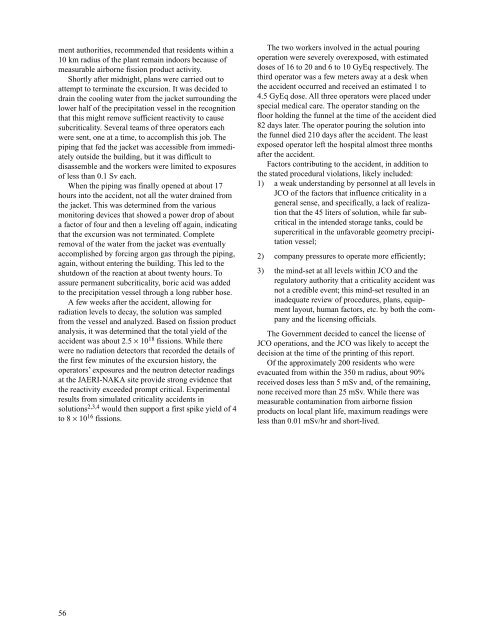A Review of Criticality Accidents A Review of Criticality Accidents
A Review of Criticality Accidents A Review of Criticality Accidents
A Review of Criticality Accidents A Review of Criticality Accidents
Create successful ePaper yourself
Turn your PDF publications into a flip-book with our unique Google optimized e-Paper software.
ment authorities, recommended that residents within a<br />
10 km radius <strong>of</strong> the plant remain indoors because <strong>of</strong><br />
measurable airborne fission product activity.<br />
Shortly after midnight, plans were carried out to<br />
attempt to terminate the excursion. It was decided to<br />
drain the cooling water from the jacket surrounding the<br />
lower half <strong>of</strong> the precipitation vessel in the recognition<br />
that this might remove sufficient reactivity to cause<br />
subcriticality. Several teams <strong>of</strong> three operators each<br />
were sent, one at a time, to accomplish this job. The<br />
piping that fed the jacket was accessible from immediately<br />
outside the building, but it was difficult to<br />
disassemble and the workers were limited to exposures<br />
<strong>of</strong> less than 0.1 Sv each.<br />
When the piping was finally opened at about 17<br />
hours into the accident, not all the water drained from<br />
the jacket. This was determined from the various<br />
monitoring devices that showed a power drop <strong>of</strong> about<br />
a factor <strong>of</strong> four and then a leveling <strong>of</strong>f again, indicating<br />
that the excursion was not terminated. Complete<br />
removal <strong>of</strong> the water from the jacket was eventually<br />
accomplished by forcing argon gas through the piping,<br />
again, without entering the building. This led to the<br />
shutdown <strong>of</strong> the reaction at about twenty hours. To<br />
assure permanent subcriticality, boric acid was added<br />
to the precipitation vessel through a long rubber hose.<br />
A few weeks after the accident, allowing for<br />
radiation levels to decay, the solution was sampled<br />
from the vessel and analyzed. Based on fission product<br />
analysis, it was determined that the total yield <strong>of</strong> the<br />
accident was about 2.5 × 10 18 fissions. While there<br />
were no radiation detectors that recorded the details <strong>of</strong><br />
the first few minutes <strong>of</strong> the excursion history, the<br />
operators’ exposures and the neutron detector readings<br />
at the JAERI-NAKA site provide strong evidence that<br />
the reactivity exceeded prompt critical. Experimental<br />
results from simulated criticality accidents in<br />
solutions 2,3,4 would then support a first spike yield <strong>of</strong> 4<br />
to 8 × 10 16 fissions.<br />
56<br />
The two workers involved in the actual pouring<br />
operation were severely overexposed, with estimated<br />
doses <strong>of</strong> 16 to 20 and 6 to 10 GyEq respectively. The<br />
third operator was a few meters away at a desk when<br />
the accident occurred and received an estimated 1 to<br />
4.5 GyEq dose. All three operators were placed under<br />
special medical care. The operator standing on the<br />
floor holding the funnel at the time <strong>of</strong> the accident died<br />
82 days later. The operator pouring the solution into<br />
the funnel died 210 days after the accident. The least<br />
exposed operator left the hospital almost three months<br />
after the accident.<br />
Factors contributing to the accident, in addition to<br />
the stated procedural violations, likely included:<br />
1) a weak understanding by personnel at all levels in<br />
JCO <strong>of</strong> the factors that influence criticality in a<br />
general sense, and specifically, a lack <strong>of</strong> realization<br />
that the 45 liters <strong>of</strong> solution, while far subcritical<br />
in the intended storage tanks, could be<br />
supercritical in the unfavorable geometry precipitation<br />
vessel;<br />
2) company pressures to operate more efficiently;<br />
3) the mind-set at all levels within JCO and the<br />
regulatory authority that a criticality accident was<br />
not a credible event; this mind-set resulted in an<br />
inadequate review <strong>of</strong> procedures, plans, equipment<br />
layout, human factors, etc. by both the company<br />
and the licensing <strong>of</strong>ficials.<br />
The Government decided to cancel the license <strong>of</strong><br />
JCO operations, and the JCO was likely to accept the<br />
decision at the time <strong>of</strong> the printing <strong>of</strong> this report.<br />
Of the approximately 200 residents who were<br />
evacuated from within the 350 m radius, about 90%<br />
received doses less than 5 mSv and, <strong>of</strong> the remaining,<br />
none received more than 25 mSv. While there was<br />
measurable contamination from airborne fission<br />
products on local plant life, maximum readings were<br />
less than 0.01 mSv/hr and short-lived.

















